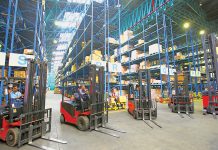Logistics hub: SinghalWelspun One logistics Parks (WOLP), backed by Welspun Group, is an industrial real estate platform offering integrated investment, asset, and development management solutions focused on logistics and warehousing in India. Anshul Singhal, MD shares WOLP’s plans to develop Grade-A warehouses and MMLPs and cater to e-commerce and pharma.
Bryan
How do you strategize your plans for future growth?
Welspun One’s goal has always been to establish a pan-Indian presence. We have plans to develop Grade-A warehouse parks on land parcels in high demand that would be leased for an extended time to tenants with AAA credit ratings from industries such as e-commerce, pharmaceuticals, FMCG, 3PL, and auto-ancillaries. We have plans to extend our portfolio and have a budget of an estimated 2,000 crore to build and lease a portfolio of 7-8 million square feet of grade-A warehouse space in India. We have targeted high growth markets to enter negotiations with landowners in tier I cities such as Mumbai, Pune, Bengaluru, Delhi, and Kolkata to acquire land parcels ranging from 40 to 75 acres. To service as many pin codes as possible, we are concentrating on tier II cities such as Ludhiana, Ghaziabad, Indore, Siliguri, Guwahati, and Vizag. Our warehouse growth is focused on technology, which is guided by the ‘3S’ principle: smarter, faster, and sustainable. By utilizing ecologically friendly alternatives when developing our logistics parks, we are contributing to a sustainable future.
How do initiatives such as GatiShakti, Make in India, and India Investment Grid help in better opportunities and projections?
The government is aware of India’s potential for storage, supply chain, and logistics industries. It is focused on planning, coordinating, and implementing infrastructure connection projects. This has been the case from GST implementation through the integration of PM GatiShakti Masterplan. The increased interest of the global markets in India as a potential logistics centre has contributed to the favourable legislation. The National Logistics Policy, which will be out soon, seeks to bring down logistics expenses from 14 per cent of Gross Domestic Product (GDP) to nearly 10 per cent. The programme will concentrate on developing a single window e-logistics market that will create jobs, expand skill sets, and boost the competitiveness of MSMEs. 35 multimodal logistics parks (MMLPs) will be built under Bharatmala Pariyojana, five are proposed in Maharashtra alone.
How crucial is the role of advanced technologies in this sector?
Though most warehouses are automated and have IoT technology, the widespread adoption of cloud computing, cloud-based operations for increasing control and visibility in the supply chain, AI, Big Data Analysis, and other technologies will help provide end-to-end smart logistics solutions, improving the logistics efficiency and release India’s true growth potential. The benefit, we as developers provide to our tenants, is that our logistics parks are designed to accommodate technology advancements. Large parks are to be constructed and they will have easy integration of supplemental operational technology. Building Grade A warehouses that incorporate green energy and sustainability is one of our top priorities. In addition to supplying rooftop solar panels and executing techniques to reduce water usage, we built zero discharge facilities. Our Bhiwandi park is IGBC Platinum certified. The park has cutting-edge features such as tech-enabled park management and maintenance, an IoT-driven traffic management system to save travel distance, and trucks with RIFD tags to predetermine directions and docking. Our customers can monitor our CCTVs from their homes or offices for more coverage of the parks.
What are the major bottlenecks?
With the fuel prices going north, the cost of transportation has also risen drastically. Finding the proper land lot at the right prices has become a difficulty. There are challenges at each level, including locating the ideal land frontage, with access to roadways for moving freight vehicles, pricing, and finding clients prepared to match rentals. Due to the scarcity of land, finding suitable land parcels in tier I cities is getting more difficult following which tier II and III cities are being considering for development of Grade A logistics parks.
Can you tell us about state-level initiatives and what are the prospects of quality infrastructure?
The GatiShakti National Master Plan is one of many initiatives that the Centre has launched. One of these is the Bharatmala Pariyojana, under which the Centre has proposed to set up 35 MMLPs to improve logistics and create centres for transportation so that the nation’s roads, rails, and waterways are seamlessly connected. The parks’ construction has been planned in Maharashtra and Karnataka and Chennai, Delhi-NCR, Bhopal, and Hyderabad. The state governments are utilizing these programs to attract funding through PPPs to guarantee improved infrastructure quality.
The states are identifying lucrative industries that may support the infrastructure. For instance, the governments of Gujarat, Tamil Nadu, and Maharashtra see electric vehicles (EVs) as a lucrative industry and are concentrating on creating industrial clusters with plug-and-play capabilities to draw EV and accessory firms. Programmes such as the Production Linked Incentive scheme place an emphasis on manufacturing, therefore warehouse firms are aiming to expand to tier II and III cities.
Around 8.6 million square feet of space was absorbed in 2021 in the tier II and III cities such as Rajpura, Lucknow, Coimbatore, Jaipur, Guwahati, Bhubaneswar, Nagpur, Kochi/Ernakulam, Indore, Hosur, and Patna. According to numerous reports, the Bengaluru warehousing market has performed well over the past year. These initiatives include the implementation of the GST, the Model Tenancy Act, and the PM GatiShakti Multimodal Master Plan.
How are you planning to make last mile delivery (LMD), and supply chain operations successful?
To get the package to the consumer as soon as possible is the main goal of last mile logistics. To make the operation successful, last-mile issues can be addressed in many ways. These include:
Enhance customer-warehouse proximity: The LMD problem would be minimized by having a warehouse close to areas where there is a high volume of orders, and it could even be used as a pick-up or drop-off location for customers.
Invest in tech for delivery optimization: With their ability to analyze real-time data for better decision-making, new technologies are facilitating process improvements.
Optimize delivery vehicle routes: Planning your route can shorten delivery times. It can be advantageous to invest in software that plans routes based on previous routes, while also taking time, vehicle capacity, location, and traffic into account to offer the most effective routes.
Communicate with users by executing delivery tracking system: Given they are not at home to collect orders, consumers need flexible deliveries. They must be updated about the status of their packages during the shipping process. Until it arrives at its destination, the businesses and customers can monitor its status with the help of real-time delivery tracking.












